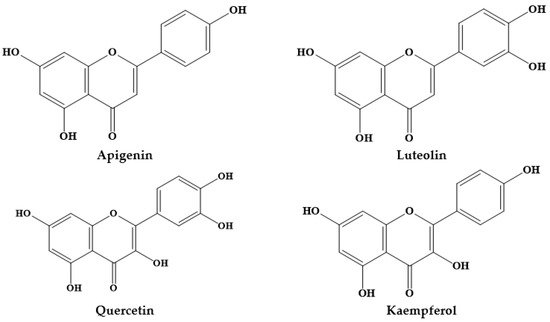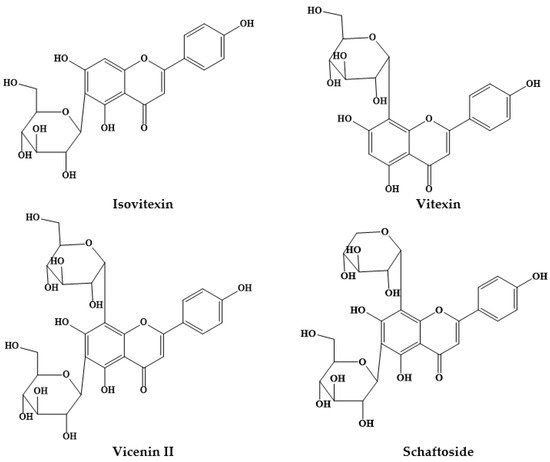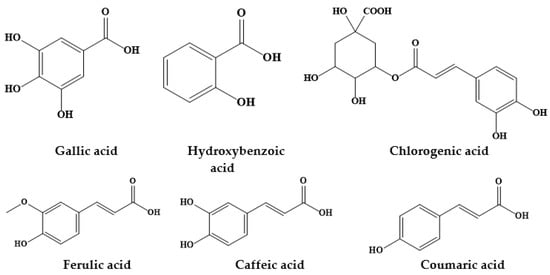Members of the Prosopis genus are native to America, Africa and Asia, and have long been used in traditional medicine. The Prosopis species most commonly used for medicinal purposes are P. africana, P. alba, P. cineraria, P. farcta, P. glandulosa, P. juliflora, P. nigra, P. ruscifolia and P. spicigera, which are highly effective in asthma, birth/postpartum pains, callouses, conjunctivitis, diabetes, diarrhea, expectorant, fever, flu, lactation, liver infection, malaria, otitis, pains, pediculosis, rheumatism, scabies, skin inflammations, spasm, stomach ache, bladder and pancreas stone removal. Flour, syrup, and beverages from Prosopis pods have also been potentially used for foods and food supplement formulation in many regions of the world. In addition, various in vitro and in vivo studies have revealed interesting antiplasmodial, antipyretic, anti-inflammatory, antimicrobial, anticancer, antidiabetic and wound healing effects. The phytochemical composition of Prosopis plants, namely their content of C-glycosyl flavones (such as schaftoside, isoschaftoside, vicenin II, vitexin and isovitexin) has been increasingly correlated with the observed biological effects.
- Prosopis
- vitexin
- C-glycosyl flavones
- food preservative
- antiplasmodial
- wound healing potential
1. Introduction
2. Prosopis Plants Phytochemical Composition



| Prosopis Plant and Part | Identified/Quantified Phytochemicals | References |
|---|---|---|
| P. alba flours | Isovitexin (1.12–0.48 μg/mg) | [9] |
| Vicenin II (1.07–0.34 μg/mg) | ||
| Vitexin (0.91–0.47 μg/mg) | ||
| Schaftoside (0.42–0.00 μg/mg) | ||
| Ferulic acid (4.01–0.28 μg/mg) | ||
| Coumaric acid (3.94–0.33 μg/mg) | ||
| P. alba pods | Q-dihexoside rhamnoside | [10] |
| Q-dihexoside | ||
| Q-methylether dihexoside | ||
| Vitexin | ||
| Q-rhamnoside hexoside | ||
| Isovitexin | ||
| Q-hexoside | ||
| K-hexoside | ||
| P. alba flour | Isoschaftoside hexoside (2.43 mg/g) | [13] |
| Schaftoside hexoside (3.33 mg/g) | ||
| Vicenin II/Isomer (0.67 mg/g) | ||
| Vicenin II/Isomer (2.34 mg/g) | ||
| Isoschaftoside (23.67 mg/g) | ||
| Schaftoside (14.86 mg/g) | ||
| Vitexin (0.46 mg/g) | ||
| Isovitexin (2.09 mg/g) | ||
| P. alba exudate gum | Ferulic acid 4-glucuronide (E) | [11] |
| Apigetrin, chrysin (E) | ||
| Chlorogenic acid (E and NE) | ||
| 3-O-feruloylquinic acid (E) | ||
| p-Coumaroylquinic acid (E) | ||
| Valoneic acid dilactone (E) | ||
| Digallic acid (E) | ||
| Ferulic acid (NE) | ||
| Esculetin derivative (NE) | ||
| 7-O-Methylapigenin (NE) | ||
| P. nigra pods | Cyanidin rhamnosyl hexoside | [10] |
| Cyanidin-3-hexoside | ||
| Peonidin-3-hexoside | ||
| Malvidin dihexoside | ||
| Cyanidin malonoyl hexoside | ||
| Petunidin-3-hexoside | ||
| Malvidin rhamnosyl hexoside | ||
| Malvidin-3-hexoside | ||
| Vicenin II | ||
| Q-dihexoside rhamnoside | ||
| Isoschaftoside | ||
| Q-dihexoside | ||
| Schaftoside | ||
| Q-hexoside rhamnose | ||
| K-hexoside rhamnoside | ||
| Isovitexin | ||
| Q-hexoside | ||
| K-hexoside | ||
| Apigenin hexoside rhamnoside | ||
| Q methyl ether hexoside rhamnoside | ||
| K-methyl ether hexoside rhamnoside | ||
| P. nigra flour | Vicenin II (0.34 μg/mg) | [14] |
| Schaftoside (0.24 μg/mg) | ||
| Isoschaftoside (0.27 μg/mg) | ||
| Isovitexin (0.81 μg/mg) | ||
| Protocatechuic acid (0.33 μg/mg) | ||
| Coumaric acid (8.16 μg/mg) | ||
| Ferulic acid (4.47 μg/mg) | ||
| P. cineraria | Protocatechuic acid (31.65 mg/g) Chlorogenic acid (22.31 mg/g) | [15,16,17] |
| Caffeic acid (6.02 mg/g) | ||
| Ferulic acid (9.24 mg/g) | ||
| Prosogerin A, B, C and D | ||
| β-sitosterol | ||
| Hentriacontane | ||
| Rutin | ||
| Gallic acid | ||
| Patulitrin | ||
| Luteolin | ||
| Spicigerin | ||
| P. laevigata | Gallic acid (8–25 mg/100 g) | [18] |
| Coumaric acid (335–635 mg/100 g) | ||
| Catechin (162.5 mg/100g) | ||
| Gallocatechin (340–648 mg/100 g) | ||
| Epicatechin gallate (10–71 mg/100 g) | ||
| Rutin (222.4–256.1 mg/100 g) | ||
| Morin (236.5 mg/100 g) | ||
| Naringenin (20 mg/100 g) | ||
| Luteolin (13 mg/100 g) | ||
| P. juliflora | 4′-O-Methylgallocatechin | [19,20] |
| (+)-catechins | ||
| (-)-mesquitol | ||
| Apigenin | ||
| Luteolin | ||
| Apigenin-6,8-di-C-glycoside | ||
| Chrysoeriol 7-O-glucoside | ||
| Luteolin 7-O-glucoside | ||
| Kaempferol 3-O-methyl ether | ||
| Quercitin 3-O-methyl ether | ||
| Isoharmentin 3-O-glucoside | ||
| Isoharmentin 3-O-rutinoside | ||
| Quercitin 3-O-rutinoside | ||
| Quercitin 3-O-diglycoside | ||
| P. glandulosa | Gallic acid (8.203 mg/g) | [21] |
| Hydroxybenzoic acid (1.797 mg/g) | ||
| Pyrocatechol (5.538 mg/g) | ||
| Caffeic acid (0.295 mg/g) | ||
| Ferulic acid (0.466 mg/g) | ||
| Quercetin (0.045 mg/g) |
3. Traditional Medicinal Uses of Prosopis Plants
| Scientific Name | Location | Local Name | Parts Used | Administration | Disease(s) Treated/Bioactive Effects | References |
|---|---|---|---|---|---|---|
| P. africana | Sélingué subdistrict, Mali | Guele | Bark trunk | Oral, Bath | Malaria | [19] |
| Guinea-Bissau | Tentera, Buiengué, Bussagan, Coquengue karbon, Késeg-késeg, Paucarvão, Pócarvão, Pó-de-carbom, Po-di-carvom, Tchelem, Tchalem-ai, tchela, Tchelangadje, Tchelem, Bal-tencali, Culengô, Culim-ô, Djandjam-ô, Quéssem-quéssem, Djeiha, Ogea | Leaves, bark, roots | Unspecified | Pains, pregnancy (childbirth, breastfeeding, diseases of the newborn), skin inflammations (wounds, burns) | [20] | |
| Nsukka Local Government Area, South-eastern Nigeria | Ugba | Leaf | Oral | Malaria | [21] | |
| North-West Nigeria | Kirya, Ko-hi | Roots | Oral | Analgesic, anti-inflammatory | [22] | |
| P. alba | Wichí people of Salta province, Argentina | Jwaayukw, Algarrobo blanco | Resin | Oral | Conjunctivitis, post-abortion pain | [23] |
| P. cineraria | Bahawalnagar, Punjab, Pakistan | Drucey | Leaves, stem | Oral | Spasm, diabetes, liver infection, diarrhea, removal of bladder and pancreas stone, fever, flu | [5] |
| Topical | Rheumatism | |||||
| Thar Desert (Sindh), Pakistan | Gujjo | Fruit | Oral | Tonic for body, leucorrhea | [13] | |
| South of Kerman, Iran | Kahour | Fruit | Topical | Asthma, skin rash | [14] | |
| Pakistan | Unspecified | Flower | Oral | Rheumatism | [15] | |
| Hafizabad district, Punjab, Pakistan | Jhand | Leaf, bark, stem, flower, fruit | Oral, topical, eye drop | Liver tonic, boils and blisters, scorpion bite, pancreatic stone, leucorrhoea, chronic dysentery, cataract | [3] | |
| Pakistan | Unspecified | Fruit, pods | Unspecified | Asthma | [4] | |
| Pakistan | Jandi, Kanda, Kandee, Jhand | Leaves, Bark, Flowers, Pods and wood | Oral | Menstrual disorders, contraceptive, prevention of abortion | [16] | |
| P. farcta | Jahrom, Iran | Kourak | Fruit | Oral | Constipation, febrifuge | [24] |
| P. glandulosa Torr | Bustamante, Nuevo León, Mexico | Mezquite | Inflorescences | Oral | Stomach pain | [25] |
| P. juliflora | Thar Desert (Sindh), Pakistan | Devi | Leaves, Gum | Oral | Painkiller, boils opening, eye inflammation, body tonic, muscular pain | [13] |
| Hafizabad district, Punjab, Pakistan | Mosquit pod | Whole plant, Flower, Stem, Leaves, Bark | Oral, topical, and as toothbrush | Galactagogue, kidney stones, toothache, breast cancer, asthma, boils | [3] | |
| Pakistan | Unspecified | Xerophytic shrub | Unspecified | Asthma, cough | [4] | |
| Mohmand Agency, FATA, Pakistan | Kikrye | Leaves | Oral | Lactation, expectorant | [17] | |
| Western Madhya Pradesh, India | Reuja | Stem bark | Oral | Asthma | [18] | |
| P. nigra | Wichí people of Salta province, Argentina | Wosochukw, Algarrobo negro | Resin | Oral | Ocular trauma, conjunctivitis | [23] |
| P. ruscifolia | Wichí people of Salta province, Argentina | Atek, Vinal | Leaves | Oral | Conjunctivitis, stomachache, pimples/rash, scabies, callouses, fever, birth/postpartum pains, diarrhoea, pediculosis, otitis | [23] |
| P. spicigera | Pakistan | Unspecified | Bark, leaves, flowers | Unspecified | Asthma | [4] |
3.1. Prosopis cineraria
3.2. Prosopis juliflora
3.3. Prosopis africana
3.4. Other Prosopis Plants
This entry is adapted from the peer-reviewed paper 10.3390/biom9120777
